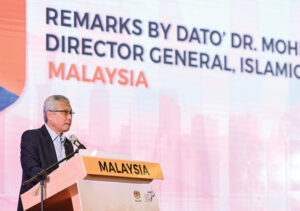Islamic Tourism Centre (ITC) has been steadfast in developing the Islamic Tourism segment throughout the years as it eyes the endless opportunities offered by the Muslim travel market to the tourism industry.
The centre took the opportunity to organise the 3rd World Islamic Tourism Conference (WITC) with the theme “Islamic Tourism: Inspiring Balance, Transformations and Solutions” on Oct 17-19, 2022, at World Trade Centre, Kuala Lumpur.
Thirty-seven moderators and speakers and 460 participants attended the event on site and online daily. An additional exhibition component was included in this 3rd edition of WITC, featuring 80 exhibitors of local and international tourism-related businesses.
Dato’ Dr Mohmed Razip Hasan, ITC Director-General, said the theme of this year’s WITC was chosen to consciously drive home a new perspective on tourism, particularly on Islamic Tourism.
“Islamic Tourism offers a balanced strategy for destinations and tourism industry players to participate in a growing tourism economy. It has the potential to positively impact all major economic sectors, opening up more business opportunities and transformative economic growth. It also offers a solution for a better world through an ecosystem founded on an Islamic framework and principle,” he said.

“What ITC would like to share here is a picture of the Muslim tourist market and its outlook for business and economic opportunities, intending to give audiences and our industry tourism players the option to participate in a growing new dimension of tourism. The information presented during this 3-day conference informs you about the Muslim tourist market and how businesses should leverage it to remain competitive.”
Main takeaways from WITC 2022
Gracing the closing ceremony of WITC 2022, Razip, in his closing remarks, shared some of the key takeaways gained from speakers and moderators throughout the three-day event. Some of the points are:
• Islamic Tourism is part of the National Tourism Policy (NTP) 2020-2030 to expedite the nation’s economic rebuilding process. Stakeholders are encouraged to explore the Muslim tourist market further because, from Malaysia’s experience, the Muslim tourist market made up 20 per cent of the overall tourist arrivals and 18 per cent of the tourist receipts Malaysia received in 2019.
• The brand concept of Muslim-Friendly tourism is suitable to attract the burgeoning Muslim market. Industry players should not focus solely on products but also on hospitality and how to serve tourists better.
• Most Muslim travellers have the same criteria as other travellers – they want to experience the world in a safe environment, without Islamophobia, and facilitated by the wonders of technology.
• The empowerment of local entrepreneurs and cooperation in attracting Muslim tourists is crucial for global tourism businesses. An innovative business programme is needed to develop industry players to level up to the needs of the domestic and international markets.
• Islamic Tourism is an ecosystem in the tourism industry that presents a global potential for sustainability; thus, tourism industry players are encouraged to adopt sustainable practices to meet the needs of the growing two billion Muslim population globally.
• Tourism players need to understand that travellers, including Muslim travellers, are now more independent in sourcing information and making travel arrangements. So, online resources and content are essential to facilitate Muslim travellers’ decision-making process and travel journey.
• The emergence of Islamic Tourism around the world creates enormous competition. Malaysia can stand out by developing a highly-recognised
standard to ensure products and services meet the stakeholders’ expectations without compromising Islamic principles and practices.
A billion-dollar socio-economic opportunity
“To conclude, times have changed, and this is the flip side of the coin. Destinations and economies can choose to see the old stereotype of Muslims or view this group with fresh perceptions and new perspectives.
“There is a growing, renewed interest
in the Muslim market, which is sophisticated and influential, a two billion global market size. But this time, unlike more than two decades ago, this interest is filled with positivity, hope and promise. By 2028, we will see an estimated 230 million Muslim tourist movements across the globe. Dismissing this Muslim tourist market segment could mean losing a billion-dollar socio-economic opportunity.”
“The question is not ‘What are Malaysia and our tourism industry players doing about it?’ but rather, ‘What are we not?’”
Razip ended his note by expressing his gratitude to the speakers, moderators and participants of WITC 2022. He wished their investment of time and attention to the 3-day event would multiply manifold in the coming days.
“May this knowledge enlighten us and shine a clear path forward in Islamic Tourism development.”








